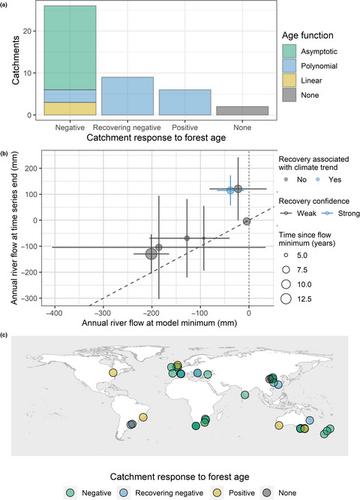当前位置:
X-MOL 学术
›
Glob. Change Biol.
›
论文详情
Our official English website, www.x-mol.net, welcomes your feedback! (Note: you will need to create a separate account there.)
Partial river flow recovery with forest age is rare in the decades following establishment.
Global Change Biology ( IF 11.6 ) Pub Date : 2020-01-19 , DOI: 10.1111/gcb.14954 Laura Bentley 1 , David A Coomes 1
Global Change Biology ( IF 11.6 ) Pub Date : 2020-01-19 , DOI: 10.1111/gcb.14954 Laura Bentley 1 , David A Coomes 1
Affiliation

|
Forest regeneration and expansion are occurring in many countries, with 80 million ha established from 2000 to 2012 under the Bonn accord and 17.5 million ha established from 1990 to 2005 according to the Food and Agriculture Organisation. Multiple reviews have linked increasing forest cover with reduced river flow and potentially detrimental effects downstream. Previous reviews have investigated trends in river flow response over time, but the influence of forest age remains uncertain. Partial river flow recovery (towards non-forested conditions) has been reported in decades following forest establishment, but the role of climate in driving these trends has not been explored. Here, we evaluate river flow trends in 43 studies following forest establishment, which provide sufficient information to distinguish the effects of ageing forests from variable climate. Our meta-analysis supports previous findings showing that forestation reduces annual river flow (by 23% after 5 years and 38% after 25 years) with greater reductions in catchments with higher mean annual precipitation, larger increases in forest cover, and which were idle, rather than agricultural land, prior to forestation. The impact of forests on river flow is sensitive to annual precipitation and potential evapotranspiration, but responses are highly variable. Forests affect river flow less when annual precipitation is low, and sensitivity to precipitation decreases as catchment aridity increases. The majority of catchments demonstrated persistent river flow declines after forest establishment. However, nine catchments showed partial flow recovery after an initial decrease, with peak flow reductions at an average age of 15 and across a range of tree species. The mean rate of recovery was 34 mm/year over 5 years. Partial flow recovery with forest age cannot be commonly expected, however, and forestation programmes should take into account that changes to annual river flow are likely to persist for up to five decades.
中文翻译:

建立后的几十年中,随着森林年龄的增长,部分河流流量很少恢复。
根据粮食与农业组织的资料,许多国家正在发生森林的再生和扩张,根据波恩协定,2000年至2012年建立了8000万公顷,1990年至2005年建立了1750万公顷。多项评论将森林覆盖率的提高与河流流量的减少以及对下游的潜在有害影响联系在一起。先前的评论已经调查了河流流量响应随时间的趋势,但是森林年龄的影响仍然不确定。在建立森林后的几十年中,已有部分河流流量恢复(向非森林状况)的报道,但尚未探讨气候在驱动这些趋势中的作用。在这里,我们评估了建立森林后的43项研究中的河流流量趋势,它们提供了足够的信息来区分气候变化带来的老龄化森林的影响。我们的荟萃分析支持以前的发现,即森林砍伐减少了年河流流量(5年后减少了23%,25年后减少了38%),集水量减少幅度更大,年平均降水量增加,森林覆盖率增加,并且闲置,而不是造林之前的农业用地。森林对河流流量的影响对年降水量和潜在的蒸散量很敏感,但是反应却变化很大。当年降水量较低时,森林对河流流量的影响较小,并且随着集水区干旱度的增加,对降水的敏感性降低。大部分集水区都表明,建立森林后,河流流量持续减少。然而,9个集水区在最初减少后显示部分流量恢复,在15岁平均年龄和各种树种中,流量峰值减少。5年的平均恢复率为34 mm /年。然而,通常不能期望随着森林年龄的增长而出现部分流量恢复,而造林计划应考虑到,每年河流流量的变化可能会持续长达五十年。
更新日期:2020-01-21
中文翻译:

建立后的几十年中,随着森林年龄的增长,部分河流流量很少恢复。
根据粮食与农业组织的资料,许多国家正在发生森林的再生和扩张,根据波恩协定,2000年至2012年建立了8000万公顷,1990年至2005年建立了1750万公顷。多项评论将森林覆盖率的提高与河流流量的减少以及对下游的潜在有害影响联系在一起。先前的评论已经调查了河流流量响应随时间的趋势,但是森林年龄的影响仍然不确定。在建立森林后的几十年中,已有部分河流流量恢复(向非森林状况)的报道,但尚未探讨气候在驱动这些趋势中的作用。在这里,我们评估了建立森林后的43项研究中的河流流量趋势,它们提供了足够的信息来区分气候变化带来的老龄化森林的影响。我们的荟萃分析支持以前的发现,即森林砍伐减少了年河流流量(5年后减少了23%,25年后减少了38%),集水量减少幅度更大,年平均降水量增加,森林覆盖率增加,并且闲置,而不是造林之前的农业用地。森林对河流流量的影响对年降水量和潜在的蒸散量很敏感,但是反应却变化很大。当年降水量较低时,森林对河流流量的影响较小,并且随着集水区干旱度的增加,对降水的敏感性降低。大部分集水区都表明,建立森林后,河流流量持续减少。然而,9个集水区在最初减少后显示部分流量恢复,在15岁平均年龄和各种树种中,流量峰值减少。5年的平均恢复率为34 mm /年。然而,通常不能期望随着森林年龄的增长而出现部分流量恢复,而造林计划应考虑到,每年河流流量的变化可能会持续长达五十年。


























 京公网安备 11010802027423号
京公网安备 11010802027423号